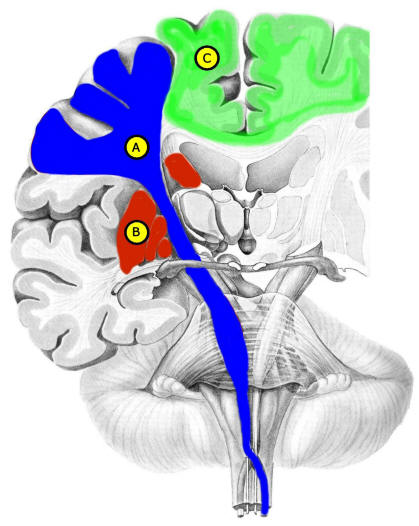| |
|
|
INCREASED MUSCLE TONE |
Even when they are not being actively contracted, skeletal muscles do not become
completely relaxed. The residual tension that exists in muscle is called
tone, and it results from sustained involuntary
contractions in skeletal muscle. When muscle tone is increased, it is often an
important sign of a central nervous system disorder.
|
|

|
|
Increased muscle tone occurs with disorders of the
upper motor neuron (A), basal ganglia (B) and frontal lobes (C): |
|
Spasticity is the increased muscle
tone associated with upper motor neuron disorders. Spasticity results from
increased deep tendon reflexes due to hyperexcitability of the muscle's stretch
reflex. Spasticity displays a "clasped knife" type of feel - initially there is
increased tone which then gives ways as the limb is moved (similar to opening a
clasped knife). Spasticity also displays a characteristic pattern, being more
prominent in the flexors of the upper extremity and the extensors of the lower
extremity.
|
Rigidity is increased muscle tone that
occurs throughout the entire range of motion of a limb that does not change with
passive acceleration by the examiner. Rigidity is often likened to the quality
of a metal being bent (i.e., lead pipe rigidity).
Characteristically, rigidity is brought out or aggravated by the activating the
contralateral limb (such as having the patient rotate their shoulder as if they
were drawing circles in the air), a phenomenon known as activated rigidity. If a
patient has both rigidity and a tremor, cogwheel
rigidity results (i.e., rachet-like resistance). True rigidity
implies basal ganglia dysfunction on the contralateral side. The most common
cause of rigidity is Parkinson's disease. Rigidity is also seen in drug-induced
parkinsonism, diffuse Lewy-body disease, progressive supranuclear palsy and
multisystem atrophy.
|
|
Paratonia is a type of rigidity in which a
limb exhibits velocity-dependent resistance in response to passive movement. The
resistance increases as the examiner increases the speed of limb movement.
Patients with paratonic limbs also demonstrate Gegenhalten
(German for "against-stop"), which is an inability to relax the limb fully for
testing of passive range of motion, and Mitgehen,
in which the patients try to help out the examiner as the examiner tries to
passively move the limb, despite instructions to remain still. Paratonia is a
less specific sign but is generally thought to represent bilateral frontal lobe
dysfunction. However, it can be seen in diffuse cerebral disorders as well. It
is frequently seen in advanced dementia. |
|
|
|